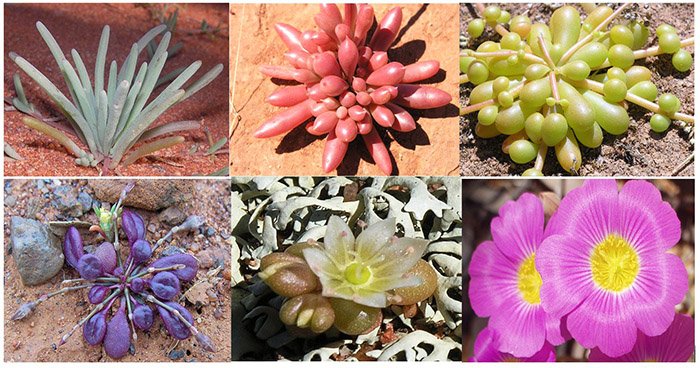Australia’s little-known, misunderstood succulent plants

WHEN THE EARLY European settlers first began exploring Australia’s arid regions, the tiny, most likely shrivelled succulent plants that lie on the desert floor would have been easy to pass by.
Even if a particular specimen had managed to catch someone’s eye – perhaps after heavy rains when the flesh becomes a healthy green – it’s unlikely it would have survived the trip back to England to be studied.
“They were never translated as worthwhile in any context, not visually or floristically, so they’ve been relegated into a sub-class,” says Attila Kapitany, who has been attempting to catalogue Australia’s succulent plants and build up their profile for more than 15 years.
He says that even the very first encyclopaedias to document the world’s cacti and succulent plants had little regard for Australian species.
“It’s recorded that Africa is rich with succulent plants, followed by the Americas and the Alps in Europe,” Attila says. “It even points out that the Canary Islands and Madagascar are all rich with succulent plants. But the encyclopaedia has a very clear paragraph which states; by contrast, Australia has very few, if any, worthy succulents, only a handful of cosmopolitan weeds.”
Attila says that this bad rap is a result of attempts by European settlers to document Australia’s succulent plants —through European language and interpretation — without fully understanding their importance to Australia’s Indigenous people.
“It’s our heritage and cultural background that has resulted in negativity towards these plants,” he says. “If the Indigenous people had remained in control, succulent plants would be better appreciated and utilised.”
An important water source
According to Attila, succulent plants found growing across Australia’s vast arid and semi-arid regions were the most significant source of water for Indigenous people.
He came to this conclusion after several conversations with renowned Australian ethnobiologist, Beth Gott.
“I’ve asked her many questions over the years, but one of them was quite revealing: where do you think they got their water from when they travelled across hot, dry land?
“Of course she’s aware that plants were eaten for their nutritional value but they were also eaten for their moisture value. They certainly didn’t carry around bottles of mineral water.
“They knew something important was readily available in the ground in many locations. These plants were highly valued for their water storage capacity in their stem, roots and leaf. You can actually travel with a stem or branch and carry it great distances.”
Indigenous people also valued succulents for their sweet tasting fruit, particularly that of the Carpobrotus, of which there are six native Australian species.
“Australian farmers call it ‘pig face’ and they feed it only to livestock. To them it isn’t deserving of human consumption. There isn’t enough money in it,” says Attila. He adds that some restaurants have added succulent plants to their menu, but only as a novelty.
“The restaurant industry have been playing and tinkering with native succulents but it’s yet to be expanded upon or done in any scale that’s really worthwhile. Most of them have it as an expensive novelty.”

Calandrinia crispisepala. (Image Credit: Attila Kapitany)
Misunderstood
Another issue in monetising succulent plants is that they’re not well described or understood.
“The two most famous Australian succulents are called pigface and pigweed. Both of these plants are considered undeserving and unworthy,” Attila says. He explains that there is a lot of previously unrecognised genetic variation in Portulaca or ‘pigweed’.
“When I travel with my wife Michele, I’ve found a genetic clone with purple and red leaves that are visually appealing. They have lovely yellow flowers and it tastes different.
“If some are sweeter and more decorative, perhaps in a salad, they’ve got more potential. But this is all because of that fundamental hiccup.
“The legacy has left such a scar that it’s stopped people wanting to experiment forever with other varieties.
“We’re being too dogmatic in our old approach to reconsider or re-evaluate their potential.”
Succulent: an adjective not a noun
“The word succulent is not a distinct position pointing to the plant’s existence; rather it’s a state of the plant,” Attila says.
Succulents, after heavy rainfall, become more colourful and more attractive to the human eye. But in seasonally dry regions they shrivel.
Attila says that for succulent plants like Calandrinia, of which there are 30 endemic Australian species, “succulence” occurs below ground, and so will not always appear succulent above surface, hence their “weedy” appearance. But their value as an important water source is undeniable.
“This wasn’t important to the early European explorers. If it wasn’t big and it wasn’t fruit-like, they didn’t care. All the tiny things were just pesky.”

Various species of Calandrinia. (Image Credit: Attila Kapitany)
More species than we think
Attila says that people are beginning to better understand the beauty and complexity of Australia’s succulent plants.
“Right at this present moment government departments are going back out to the desert to re-explore and coming back with high numbers of new, undescribed species. They were basically skimmed over in the past.
“Over the next five to 10 years it’s likely that there’ll be a lot of new species described, so this is just the beginning.”

Australia’s leading expert on succulent plants Attila Kapitany.
You can see more of Attila’s work with Australia’s native succulents by visiting his website ww.australiansucculents.com

